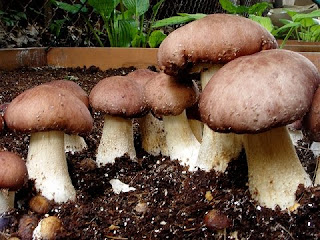 Cultivating
mushrooms at home has become fairly popular in recent years because
of the wide availability of the supplies needed to grow fungi
variants that produce edible mushrooms.
Cultivating
mushrooms at home has become fairly popular in recent years because
of the wide availability of the supplies needed to grow fungi
variants that produce edible mushrooms.
The
methods employed for growing edible mushrooms have not changed a lot
these past few decades. The methods haven't changed because the whole
process of growing mushrooms has always been straightforward and
effective. As the old adage goes, if something isn't broken, why fix
it?
Step 1: Pure Culture
Modern
mushroom cultivation actually begins in the confines of your basement
or home mushroom workshop. Before you can begin growing mushrooms in
plastic bags, you need to obtain and multiply pure culture. Pure
culture is really just the mycelium of the target species of fungi.
Mycelium
is like the seed that will later produce the edible mushrooms that
you're after. Mushrooms are just the fruiting bodies of fungi
species. They are produced when conditions are right so as a mushroom
grower, it would be your job to ensure that the right number of
favorable conditions is present when you start bagging the substrate
and the grain spawn.
In
the first phase of the process, you need to obtain some culture of
the target species. This culture will then be grown in petri dishes
with agar. Agar is just the medium that will hold the mycelium.
Molasses and other nutrient-rich items can be mixed with the agar to
ensure maximum mycelium growth.
Step 2: Create Grain Spawn
When
the mycelium has grown, it can be stored for months until you are
ready to create the grain spawn. Grain
spawn is
needed to inoculate big batches of substrate. You can create grain
spawn by adding pure culture to rye grains.
It
takes about ten days for the rye grain to be ready. After this spawn
run you need to use the rye grain immediately while it is still
viable. Otherwise, the rye grain might end up being unusable because
the mycelium will grow nonstop inside the sterile jars.
Of
course, you would want to inoculate more than a few bags of
substrate. You will need more than one batch of viable grain spawn.
You can increase the amount of grain spawn by adding small amounts of
viable grain spawn to sterilized rye grains.
One
jar of viable grain spawn can give rise to ten more jars of grain
spawn. If you produce ten jars of grain spawn from pure culture, you
can definitely produce up to a hundred more jars of grain spawn by
carefully measuring and distributing the contents of the first
generation jars.
Final Step: Inoculate Substrate
The
final step is inoculating your chosen substrate. The two most popular
choices when it comes to growing common edible mushrooms are wood
chips and wheat straw. If you have been able to obtain freshly cut
wood chips you won't have to sterilize it anymore. Wheat straw is
another story.
You
need to sterilize it before adding the grain spawn. If you want to
inoculate wood chips, you will need a rake so you can distribute the
grain spawn evenly throughout each batch of substrate. If you are
planning to use wheat straw, you need uniformly-sized polyethylene
bags.
Categories:
mushroom grain spawn
mushroom growing substrate
mushroom mycelium
mushroom substrate
mushroom substrate jars
mushroom substrate recipe
oyster mushroom substrate
spent mushroom substrate
Read More










